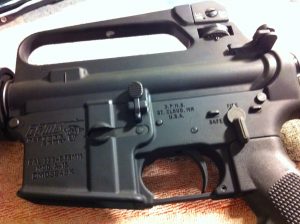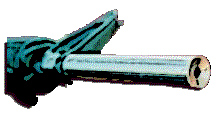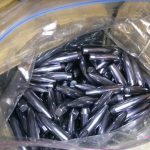 The king of the AR-15 single stage is JP Enterprises. Others do exist, like the Derrick Martin, which is supposed to be quite good, but the JP can be purchased just about anywhere. The JP is also very common as an OEM match-trigger system, and can be had from just about any AR-15 manufacturer (Note: the JP 4 ½ lbs. trigger in the Ghogkiller’s DPMS “DCM” rifle is as sweet as mine, and I spent four hard hours and two disconnectors on mine). I got one of mine from Midway for goodness sake! The other one I did for my match gun was purchased directly from JP, which I highly recommend. One phone call and I had my fire control system in two days.
The king of the AR-15 single stage is JP Enterprises. Others do exist, like the Derrick Martin, which is supposed to be quite good, but the JP can be purchased just about anywhere. The JP is also very common as an OEM match-trigger system, and can be had from just about any AR-15 manufacturer (Note: the JP 4 ½ lbs. trigger in the Ghogkiller’s DPMS “DCM” rifle is as sweet as mine, and I spent four hard hours and two disconnectors on mine). I got one of mine from Midway for goodness sake! The other one I did for my match gun was purchased directly from JP, which I highly recommend. One phone call and I had my fire control system in two days.
The JP can be had in degrees. One could purchase the trigger only for $99 and use the stock hammer, pins and springs. This is what I have on my service rifle and I think this is all you need for the 4 ½ pound setup. Mine has been rock solid. For a match rifle I recommend the fire control system kit for $169 direct from JP. This includes the trigger, match springs, oversize moly receiver pins, and the speedlock hammer. John at JP says he matches these parts when he makes a kit. My match rifle breaks like a bolt gun trigger at 2 ½ lbs. using very conservative settings. If you like, overtravel can be completely eliminated, I like just a tetch’ of overtravel. Creep is non-existent.
This system is drop dead reliable. I have never had a double as a result of the trigger. (Little advice: if you blow some primers, look underneath the trigger very carefully. I mean very carefully!
A crisp 4 ½ pounds does not feel like 4 ½ pounds.
If the trigger breaks exactly the same every time, your finger will get smart quick. I have noticed no advantage of moving a first stage through 3 ½ pounds over pre-loading a single stage 3 ½ pounds with my finger.
Less moving parts, always good over the long haul.
The only cutting required for fitting this system is done to the OEM disconnector, which can be had at a gun show for $4. The fire control system comes with an extra. If you screw it up, no harm, no foul.
The back of the trigger must be cut to fit the safety, but this fit has no ultimate effect on the quality of break. Go slow and this is no problem. I recommend that the safety be kinda’ hard so that the trigger is held securely. The reset on the JP is very short.
Adjustable from the top for sear engagement (creep) and overtravel. Pull weight is a function of the trigger and hammer springs.
Instructions for installation are second to none and John can help over the phone.
I think the single stage triggers have gotten a lot of bad talk because most of the Highpower shooters started on the .30 caliber’s. A lot of guys want their AR’s to feel like an M1A. I have heard gunsmiths say a lot of uninformed things about the new single stage triggers that are a leftover from the days of stock trigger jobs. Let me just say, the disconnector function on a JP trigger is just as good as the disconnector function on a Milazzo. When both are properly timed, a disconnector is a disconnector. I have seen no evidence that one trigger outlasts another, there are many good specimens to be had.
I think that one thing to look for is adjustability. Just face the fact that bearing surfaces wear and will need to be adjusted eventually. I haven’t touched my JP’s since they went in both my rifles, but I do know that I could add a ¼ turn of sear engagement if I need to, and it would only take about two minutes to do.
I comment on my triggers:
I was at Perry this year looking for my friend Junior who was shooting in leg match in the Nationals (never did find him). I had made a point to get to Perry during Highpower week so I could see all the cool AR-15 stuff in commercial row. I was in talking to my friend Carl who owns Champion Shooter’s Supply. I just happened to step into his shop when Mr. Zylanak of Zylanak Sights walked in to do some business with Carl. We started shooting the poop a bit and I asked him some questions about my Zylanak sight that was on my match rifle. I told him that it was out in the truck and he wanted to check it out. No sooner than I had the rifle out of the case, he asked if I wanted to buy a Jewel trigger. I told him that I was very happy with my JP. One pull of the trigger and he was in agreement that there was no reason to switch. The Jewel was no better!
I get the same response about my service rifle trigger, no one believes it is 4½ pounds! If this makes any sense, I think that the low duration of force required to break an extremely crisp trigger feels lighter than a lighter trigger with any hint of creep. Pay attention to quality of the break not the quantity.
To conclude my little article, I will just say that the AR-15 trigger mechanism is somewhat limited in its current configuration. That is, in relation to a bolt gun trigger. The problem is that the pull weight of the trigger is heavily dependent on the tension in the hammer spring. The force present in the hammer directly acts on the sear. This same spring is also directly related to lock time. The most positive way to lessen the trigger pull weight can be had by lightening the hammer spring. The problem is you just created another problem related to lock time and primer strike. JP Enterprises does address this in their fire control system. The hammer spring they supply is much lighter than OEM, but so is the speedlock hammer! This is how they easily achieve a 3 lb. trigger. I do not know if lock time is reduced with the JP hammer, but I do know the trigger weight is reduced by a few pounds with substitution of the JP spring. 

![The Single Stage AR-15 Trigger (1999) The king of the AR-15 single stage is JP Enterprises. Others do exist, like the Derrick Martin, which is supposed to be quite good, but the JP can be purchased […]](https://theurbanrifleman.com/wp-content/uploads/2013/04/IMG_20691-620x300.jpg)


